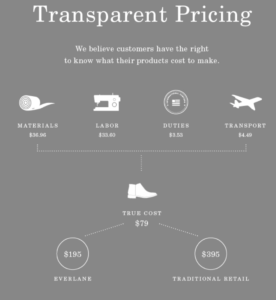 In today’s globalized world, supply chains have become more and more complex, and it is even more challenging to ensure compliance of your entire supply chain.
In today’s globalized world, supply chains have become more and more complex, and it is even more challenging to ensure compliance of your entire supply chain.
Big companies invest a great deal of effort into ensuring their entire supply chains are compliant with their values and standards, as well as with governmental regulations. But how can small business owners achieve full transparency into their supply chains without the resources of big companies?
First, what do you need to do to discover your supply chain?
- Determine your company’s strengths
To help identify what is most important for you to monitor in your supply chains, first identify your company values and what you want to promote to your customers. For example, are you concern by social compliance, digitalizing your documents, sustainability, etc.? Or is your added value in the origin of your products or a claim that you add to your packaging?
- Research your products and components
To ensure conformity of your products, you need to know and confirm all information related to the components that make up your products. Your need to collect all datasheet and any other information that can be provided for each component, such as certifications, certificate of analysis, country of origin, etc.
- Identify all your suppliers and sub-contractors
You need to know who you are working with. You need to make sure they will deliver on their promises by gathering information about:
- Who they are, down to the bottom of the supply chain
- Where are their facilities located
- If they have any certifications
- If they subcontract any work to other companies
Compiling these data in one place will allow you to identify challenges, get analytics on certification status, store all suppliers contact information, etc.
- Make an action plan
You cannot tackle transparency on all fronts at once. You need to decide where to start based on your priorities and/or higher potential risk areas, such as:
- A defined product category that represents a high percentage of your revenue
- A list of sensitive components that can cause allergic reactions
- Specific countries with high risk of forced labor
- A set of suppliers that haven’t disclosed all their information
Second, you need to decide how you will collect this information.
- Do it yourself: collect the information, keep it up to date, and visit your suppliers’ facilities all over the world
- Hire a third-party provider that specializes in supply chain mapping and risk management, and a certification body to audit and visit all your suppliers’ sites.
Hiring a third-party company specialized in supply chain transparency will allow you to focus on your core business: selling, marketing, and business development. It will also facilitate your supplier relationships and data management.
How can Transparency-One help?
Transparency-One helps companies of all sizes map their suppliers down to the lowest level of the supply chain, regardless of where they are based. Each supplier can store and share specific information and certifications related to their products and facilities. Companies can then drill down into their supply chain to identify which suppliers have filled out all their information and which lack valid certifications or information, thereby gaining the complete supply chain visibility needed to take action.
Transparency-One’s partnership with SGS, the world’s leading inspection, verification, testing and certification company, brings additional functionalities. SGS onboards your suppliers onto the platform, verifies the validity of uploaded certificates, with a global presence in over 140 countries, can also provide onsite visits to all your suppliers, wherever they are located.
A set of analytics integrated in the platform give you an overview of your supply chain transparency efforts and help you identified challenges by criteria, such as country of origin, lack of social certification, and more.
Example of a SMB company: Everlane
Everlane, a US fashion retailer, has already implemented pricing transparency on their website by detailing the cost at each step of the supply chain, providing the consumer with insight on the true cost of the product being purchased. Pricing transparency, in addition to price itself, could soon become a competitive differentiator that will give consumers additional criteria for evaluating the clothes and products they buy.
Achieving transparency in your supply chain will take some time, but will be well worth the effort in the long run. That is why you need to choose the right provider from the start to help you achieve complete transparency.










